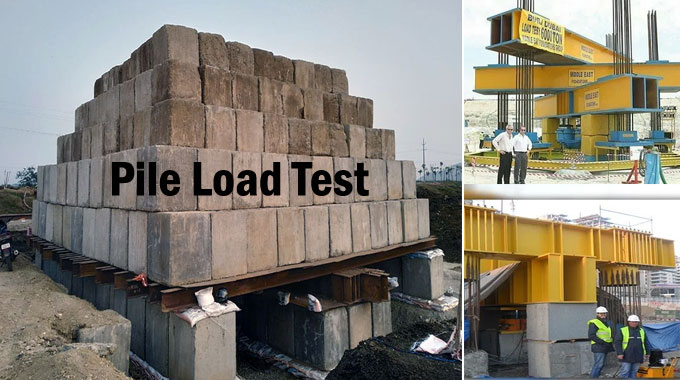
Pile Load Test: The Absolute Safety for Construction Structure
The reason of pile load test is:
- To find out settlement under working load.
- To find out ultimate bearing capacity.
- To establish as a proof of acceptability.
Various types of Pile Load Test | Function of Pile Load Test
In common two types of pile load tests are conducted. They are:
1. Initial Test
2. Routine Test
The initial test is worked before the start of structure to assess the design sufficiency. The routine test is worked on a working pile.
This test knew as work test. In preliminary test, the test load 5/2 times the working load in work test load is 3/2 times the design load.
Testing Method
Two methods of testing piles are:
1. Maintained Test
2. Constant Rate of Penetration Test (CRP)
Maintained Load Test
The maintained load test is a method which is better. This method gives a thought of both shaft and end resistance. The contribution of each soil layer can be calculated but it takes lot of time in this method. The failure load is amorphous.
Loading ? The load is applied by any one of the following methods depending upon the workload.
- Directly throughout a kentledge for minor loads.
- By taking retort against a kentledge for loads up to 5000 kN.
- By jacking in opposition to a beam or truss between adjoining anchor piles or loads superior than 5000 kN.
Distance Between anchor piles to test pile
The distance can be greater than 1.5 m. It should be lesser than 4 times the diameter of test pile for straight pile and greater than 2 times the diameter of the bell for belled pile.
Load Application ? The load is applied in the pile in the following order.
- 25 % increment Load applied of working load till working load is reached.
- Sustain the load constant till settlement is 0.1 mm for 5 min as per IS Code, 0.1 mm for 20 min as per BS Code for each load augmentation.
- Go for subsequent loading.
- When working load is reached hold the load for 24 hr and drop.
- Restock from working load to upper loads.
- Hold load stable till settlement is 0.1 mm for 5 min as per IS Code, 0.1 mm for 20 min as per BS Code.
- Repeat the process for successive load increments.
- Go up to 5/2 times the working load for initial or routine test. For belled pile a settlement equal to 10 % of pile diameter for straight piles and 7.5 % of base diameter.
Measurement of Load
The measurement of load is done by any one of the following equipment.
i. Burdon Gauge
ii. Proving Ring
iii. Load Cell
Measurement of Settlement
The settlement is precise either by a dial gauge or by a leveling instrument.
Ultimate Load ? 2/3 of final load casing 12mm settlement and ? of load causing a total settlement of 10% of pile diameter for straight piles or 7.5% of base diameter for a belled pile take to the failure load.
Regular Rate of Penetration Test
This test is most appropriate for friction pile. The well defined failure load is obtained and the method is very fast. However, this method does not supply elastic settlement at working load.
Testing Method ? The pile is jacked constantly into soil at a stable rate till failure takes place in this method.
The clay jacking rate is 0.75 mm/min and a little movement required for failure. The jacking rate is 5 mm/min and a large movement required for failure in sands.
Failure ? The failure is defined when the Load at which pile continues to move downwards without any additional loading or settlement is 10 % of pile diameter.


